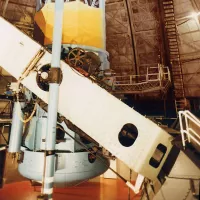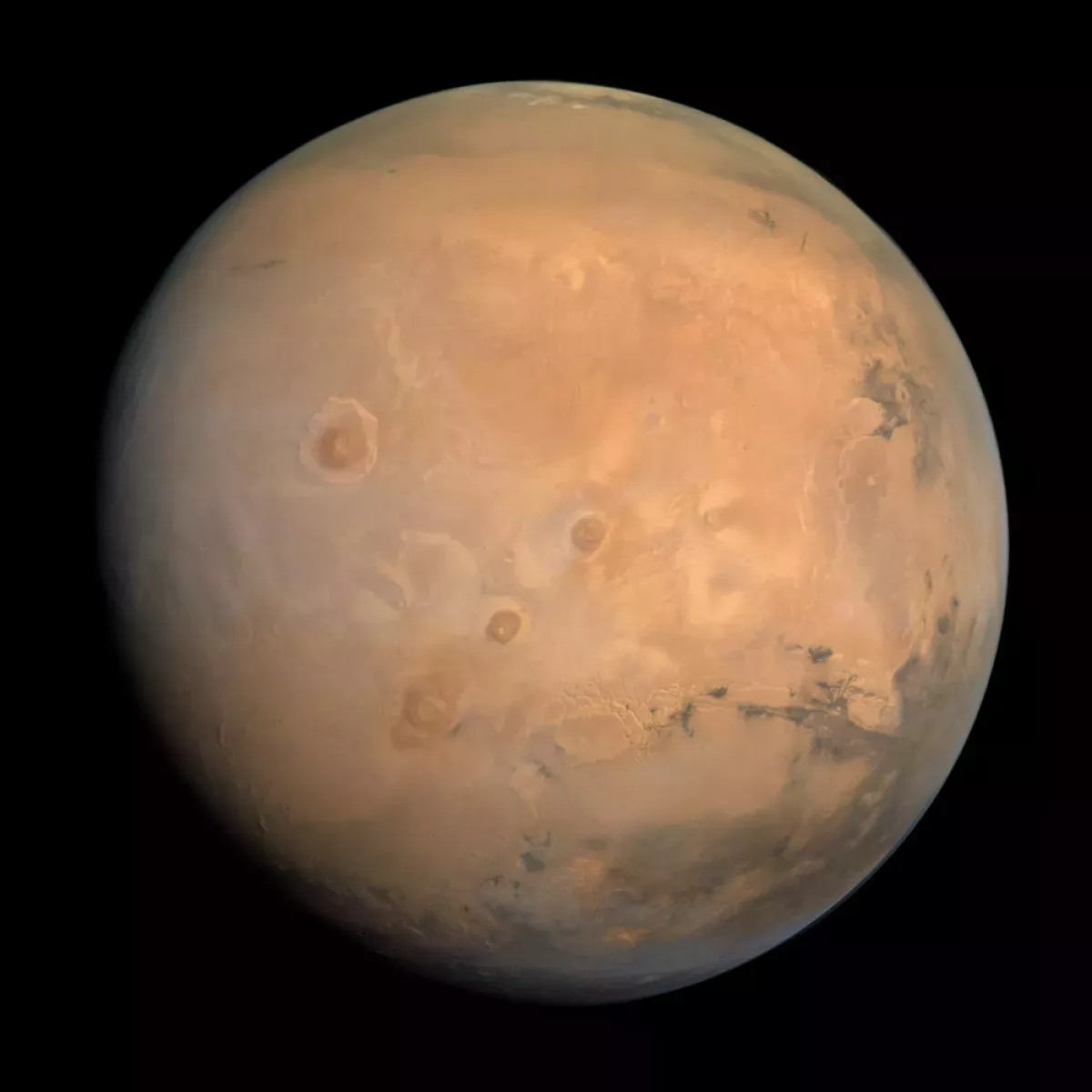Mars is the fourth planet from the Sun, known as the "Red Planet" due to its orange-red appearance. It's a rocky, desert-like planet with a thin, primarily carbon dioxide atmosphere. The atmospheric pressure and temperature are significantly lower than Earth's, and cosmic radiation is high. While Mars retains some water in the form of ground ice, atmospheric vapor, clouds, and polar ice caps, there are no stable bodies of liquid surface water. Mars' surface gravity is about one-third of Earth's. It has a diameter of 6,779 km and a surface area equivalent to Earth's landmass.
1909: Observations by Antoniadi
During observations in 1909 by Antoniadi with an 84-centimetre (33 in) telescope, irregular patterns were observed on Mars, but no canali were seen.
1909: Campbell and Slipher Repeat Study
In 1909, W. W. Campbell and V. M. Slipher repeated their earlier study of Mars using better instruments, but they achieved the same results. They found little to no evidence of water vapor or oxygen in the Martian atmosphere.
1925: Adams Confirms Findings, Breaks Myth
In 1925, W. S. Adams confirmed the findings of Campbell and Slipher, which finally debunked the myth of Mars being an Earth-like, habitable planet. This confirmation was a significant turning point in the understanding of Mars.
1938: Publication of 'Out of the Silent Planet'
In 1938, C. S. Lewis published "Out of the Silent Planet", which is a science fiction novel depicting Mars, further stimulating interest in the planet and its potential for life.
1948: Marvin the Martian Debut
In 1948, the character Marvin the Martian debuted in Haredevil Hare, a Looney Tunes cartoon by Warner Brothers. This depiction of an intelligent Martian contributed to the popular culture's fascination with the possibility of life on Mars.
1963: Flyby from Mars 1
In 1963, the Soviet Union's Mars 1 flew by Mars, but contact was lost en route.
1963: First flight to Mars
In 1963, the first flight to Mars took place with Mars 1, but communication was lost en route.
July 1965: Closest approach of Mariner 4
On 15 July 1965, Mariner 4 made its closest approach to Mars, detecting the weak Martian radiation belt and capturing the first images of another planet from deep space.
1965: First successful flyby of Mars
The first successful flyby exploration of Mars occurred in 1965 with Mariner 4.
1971: First spacecraft to orbit Mars
In 1971, Mariner 9 became the first spacecraft to orbit Mars, marking the first time a spacecraft orbited a celestial body other than the Moon, Sun, or Earth. Also in 1971, the first uncontrolled impact (Mars 2) and the first successful landing (Mars 3) on Mars occurred.
1972: Selection of Prime Meridian
In 1972, after Mariner 9 provided extensive imagery, Merton E. Davies, Harold Masursky, and Gérard de Vaucouleurs chose a small crater (Airy-0) in Sinus Meridiani to define 0.0° longitude for Mars.
1982: Viking 1 shut down
In 1982, Viking 1 shut down.
1988: Phobos 1 flying past without contact
In 1988, Phobos 1 flew past Mars without contact.
1989: Phobos 2 malfunctioning in orbit
In 1989, Phobos 2 malfunctioned in orbit before reaching its destination Phobos.
1993: Mars Observer flying past without contact
In 1993, Mars Observer flew past Mars without contact.
1997: Successful rover mission
In 1997, Mars Pathfinder became the first successful rover mission beyond the Moon and started, together with Mars Global Surveyor, an uninterrupted active robotic presence at Mars.
1997: Continuous probe activity on Mars begins
Probes have been continuously active on Mars since 1997, with periods where more than ten probes simultaneously operated in orbit or on the surface.
1997: Mars visited by three unsuccessful probes
Until 1997, Mars was only visited by three unsuccessful probes.
1999: Hypothesis of plate tectonic activity on Mars
In 1999, a hypothesis suggested that bands of magnetized crust on Mars indicate plate tectonic activity four billion years ago, before the planet's magnetic field faded.
2000: Estimated Core Temperature
Around the year 2000, the temperature of Mars's core was estimated to be between 2000–2400 K.
2001: Global dust storms
In 2001, global dust storms on Mars suspended dust in the atmosphere for 0.6 years.
2004: Detection of Jarosite
In 2004, Opportunity detected jarosite, a mineral that forms only in the presence of acidic water, indicating the past existence of water on Mars.
October 2005: Re-examination of plate tectonic activity hypothesis
In October 2005, the hypothesis of plate tectonic activity on Mars was re-examined with the help of the Mars Global Surveyor.
2006: Mars Global Surveyor operated until late 2006
In late 2006, Mars Global Surveyor stopped functioning. It produced complete, extremely detailed maps of the Martian topography, magnetic field and surface minerals.
2007: Silica deposits indicate wet conditions
In 2007, the Spirit rover found concentrated deposits of silica, indicating past wet conditions on Mars.
December 2011: Discovery of gypsum
In December 2011, NASA's Mars rover Opportunity discovered the mineral gypsum on the surface of Mars, which also forms in the presence of water.
2012: Valles Marineris and plate tectonics
In 2012, a proposal suggested that Valles Marineris is a plate boundary with transverse motion, indicating Mars might have a two-tectonic plate arrangement.
March 2013: Evidence of mineral hydration
On 18 March 2013, NASA reported evidence from instruments on the Curiosity rover of mineral hydration in several rock samples and subsurface water amounting to as much as 4% water content.
2014: Analysis of Martian Meteorite EETA79001
In 2014, an analysis of the Martian meteorite EETA79001 revealed significant concentrations of chlorate, perchlorate, and nitrate ions, suggesting their widespread presence on Mars. The study also indicated that UV and X-ray radiation would convert chlorate and perchlorate ions into highly reactive oxychlorines, posing challenges for the survival of organic molecules on the Martian surface.
March 2015: Ocean Theory
In March 2015, scientists stated that an ancient ocean on Mars might have been the size of Earth's Arctic Ocean, derived from the ratio of protium to deuterium in the Martian atmosphere.
September 2015: Evidence of hydrated brine flows
In September 2015, NASA announced they had found strong evidence of hydrated brine flows in recurring slope lineae, based on spectrometer readings of the darkened areas of slopes.
November 2016: Large amount of underground ice found
In November 2016, NASA reported finding a large amount of underground ice in the Utopia Planitia region, estimated to be equivalent to the volume of water in Lake Superior.
September 2017: Increased radiation levels and aurora
In September 2017, NASA reported doubled radiation levels on Mars's surface and an aurora 25 times brighter than previously observed due to a solar storm.
2017: NASA Authorization Act of 2017
In 2017, the NASA Authorization Act directed NASA to conduct a study on the feasibility of a crewed Mars mission in the early 2030s. The study ultimately concluded that such a mission would be unfeasible.
2018: Indications of water in Valles Marineris
During observations from 2018 through 2021, the ExoMars Trace Gas Orbiter spotted indications of water, probably subsurface ice, in the Valles Marineris canyon system.
2019: Marsquakes detected by InSight
In 2019, it was reported that InSight had detected and recorded over 450 marsquakes and related events, confirming that Mars is seismically active.
2020: Particularly close perihelic opposition
In 2020, a particularly close perihelic opposition of Mars occurred.
2021: Indications of water in Valles Marineris
During observations from 2018 through 2021, the ExoMars Trace Gas Orbiter spotted indications of water, probably subsurface ice, in the Valles Marineris canyon system.
2021: China's Crewed Mars Mission Plans
In 2021, China announced plans to send a crewed mission to Mars in 2033, furthering the international interest in human exploration of the planet.
April 2023: Updated global map of Mars
In April 2023, The New York Times reported on an updated global map of Mars based on images from the Hope spacecraft, and NASA released a more detailed global map on April 16, 2023.
2023: Evidence of a past ring system
A study in 2023 suggests that Mars may have had a ring system between 3.5 and 4 billion years ago, based on the orbital inclination of Deimos. Phobos may be a remnant of that ring.
2023: Ten functioning spacecraft
As of 2023, Mars is host to ten functioning spacecraft.
April 2024: SpaceX's Mars Colonization Plans
In April 2024, Elon Musk shared plans with SpaceX envisioning the beginning of a Mars colony within the next twenty years. This would be facilitated by mass manufacturing of the Starship launch vehicle, initial resupply from Earth, and in-situ resource utilization on Mars until the colony becomes self-sustainable.
April 2024: NASA Selects Companies for Commercial Services Studies
In April 2024, NASA selected multiple companies to begin studies focused on providing commercial services to enhance robotic science on Mars. Key areas of study include establishing telecommunications, payload delivery, and surface imaging capabilities.
June 2024: Cheyava Falls Rock Designated as Potential Biosignature
In June 2024, NASA designated the Cheyava Falls rock on Mars as a "potential biosignature". The Perseverance rover collected a core sample for possible return to Earth and further examination, though no definitive conclusion on a biological or abiotic origin could be made with the currently available data.
2025: Detection of a solid inner core
In 2025, researchers reported the detection of a solid inner core with a radius of 613 kilometres ± 67 kilometres, based on data from the InSight lander.
2033: Planned Date for China's Crewed Mars Mission
In 2033, China is planning to send a crewed mission to Mars, according to plans announced in 2021. This highlights the ongoing global efforts toward human exploration of Mars.
2033: Particularly close perihelic opposition
In 2033, a particularly close perihelic opposition of Mars will occur.
2035: Opposition near perihelion
In 2035, Mars will come into opposition from Earth near its perihelion.
Mentioned in this timeline

Elon Musk is a prominent businessman and entrepreneur recognized globally...

SpaceX founded in is a private American aerospace manufacturer and...
The Union of Soviet Socialist Republics USSR existed from to...
NASA the National Aeronautics and Space Administration is an independent...
China officially the People's Republic of China PRC is an...

A telescope is an instrument used to observe distant objects...
Trending

Simon Cowell is a prominent English television personality and businessman recognized for his role as a judge on various talent...

7 months ago Gary Payton Reflects on Jordan Matchup and Hypothetical Stats in Today's NBA

11 days ago Spurs Defeat Nuggets in Thrilling Game, Mavericks Face Nuggets

22 days ago Michael Douglas and Catherine Zeta-Jones Celebrate 25 Years of Marriage with Throwbacks
Luke Kornet is an American professional basketball player currently playing for the San Antonio Spurs in the NBA He's a...

6 months ago Jack Black's Minecraft Movie Sets Premiere on HBO Max, June 20, 2025
Popular

Candace Owens is an American conservative political commentator and author...

Ilhan Omar is an American politician currently serving as the...

XXXTentacion born Jahseh Dwayne Ricardo Onfroy was a controversial yet...

Tom Cotton is an American politician and Army veteran currently...
The Kennedy Center Honors are annual awards recognizing individuals and...

Kelsey Grammer is an accomplished American actor producer and singer...
